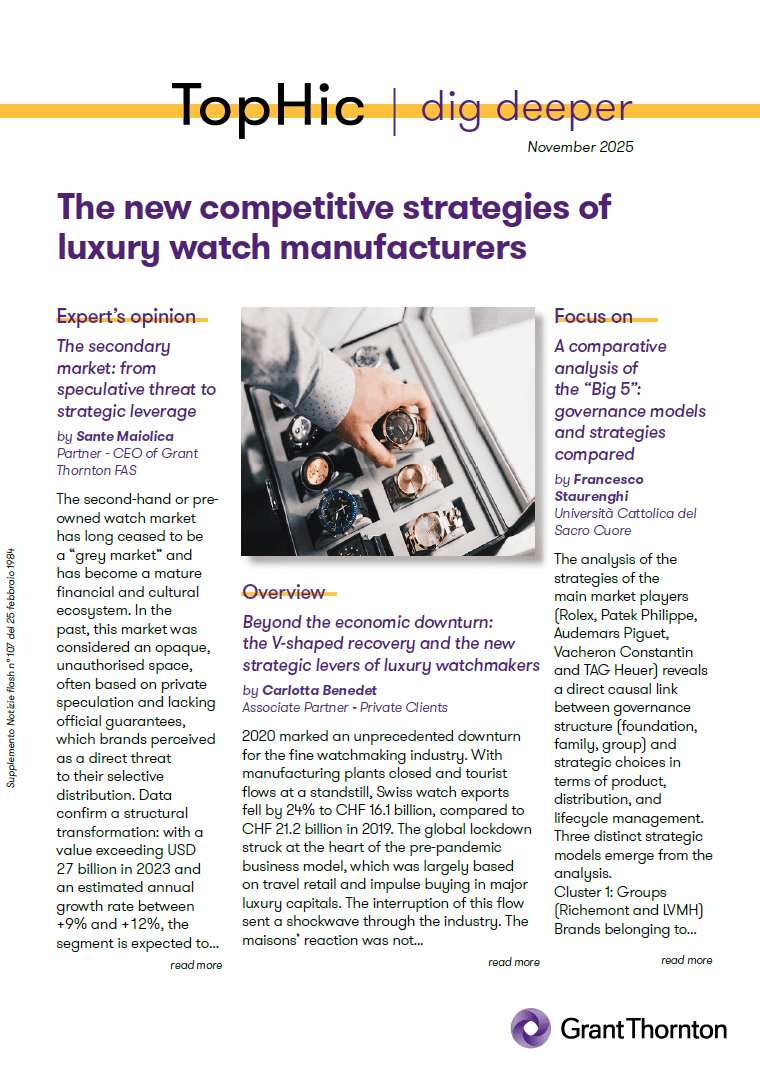
2020 marked an unprecedented downturn for the fine watchmaking industry. With manufacturing plants closed and tourist flows at a standstill, Swiss watch exports fell by 24% to CHF 16.1 billion, compared to CHF 21.2 billion in 2019. The global lockdown struck at the heart of the pre-pandemic business model, which was largely based on travel retail and impulse buying in major luxury capitals. The interruption of this flow sent a shockwave through the industry. The maisons’ reaction was not panic-driven; far from that, they responded with a strategic crisis management, halting the launch of new products and doubling down on shortage management. Instead of selling off or seeking volumes in a depressed market, large groups preferred to protect the exclusivity and perceived value of their products: a counterintuitive move that avoided brand devaluation. Such a stress test rewarded the most resilient business models.
What followed was an extraordinarily intense “V-shaped” recovery, a surprisingly quick rebound that rapidly surpassed pre-Covid levels. By 2023, exports had already reached a record value of CHF 25.5 billion. This explosive growth has been fuelled by new drivers: pent-up demand, of course, but above all a boom in collecting, with watches increasingly perceived as a safe haven in a context of economic uncertainty that has pushed capital towards tangible and transportable hard assets, as well as an exponential growth in the US market. The latter, in particular, has become the world's largest market, overtaking China, thanks to a combination of tax incentives, an explosion of new wealth (often linked to the tech and crypto world) and a new luxury culture focused on men's collectibles.
The pandemic and the subsequent recovery have accelerated the transition towards an oligopolistic and selective market structure. A phenomenon known as flight to quality: in uncertain times consumers don’t stop spending, but focus their spending on brands perceived as safer, iconic and more likely to retain their value over time. Data are unequivocal: Rolex alone controls over 30% of the global market, and the top four maisons together (Rolex, Cartier, Omega and Patek Philippe) account for over 50%. For brands not included in this “club” the room for manoeuvre has shrunk dramatically. They struggle to gain media visibility, secure space in multi-brand distribution channels (increasingly dominated by the “Big 4”) and justify their pricing power lacking a speculative demand or an established iconic status.
Competition is no longer based on products, often technically excellent also among minor brands, but rather on the ability to create and maintain oligopolistic brands. Success in this industry is based on intangible levers, defined as the “identity levers” of symbolic luxury:
- Scarcity: Strategic management of limited availability. This is not a “real” scarcity (production inability), but rather an “orchestrated” scarcity. It means consistently producing less than market demand in order to fuel waiting lists, generate conversation and transform the purchase from a simple transaction into an achievement, a privilege granted by the brand;
- Selectivity: Strict control of distribution channels and customers. This translates into a drastic reduction in authorised multi-brand retailers in favour of directly managed single-brand boutiques. By controlling the points of sale, the maison controls the customer experience, sales data, and, above all, decides “to whom” to sell the most sought-after models;
- Desirability: It’s the final outcome of this management style, which translates into brand equity, pricing power and intangible assets of increasing value. This is the Holy Grail of luxury: the ability to increase list prices year after year (pricing power) without affecting demand but rather strengthening it. Desirability transforms watches from objects into status symbols, an entry ticket to an exclusive club.
The success of these levers is measurable. Between August 2018 and January 2023, the CAGR (Compound Annual Growth Rated) of Rolex, Patek Philippe and Audemars Piguet, leading players in the secondary market, was equal to +20% on average. Over the same period, the S&P 500 index averaged 8%. This differential isn't just a statistic, but evidence that luxury watches have become an alternative financial asset. The high-end watchmaking sector has demonstrated its ability to generate financial alpha unrelated to traditional markets and based not on physical assets, but on the masterful management of intangibles, worthy of protection and preservation.
